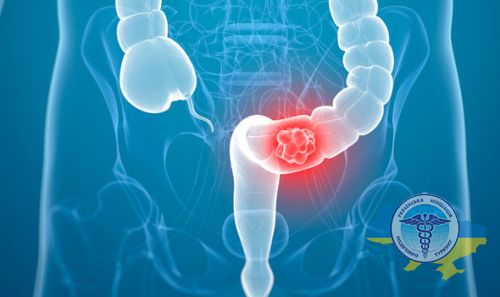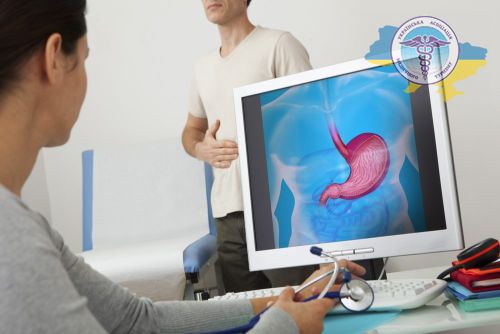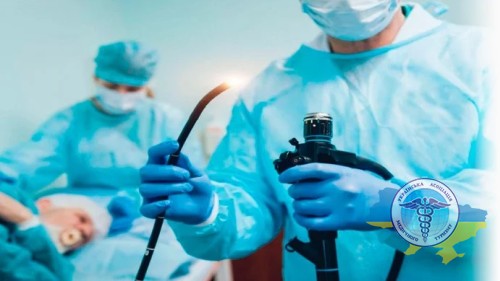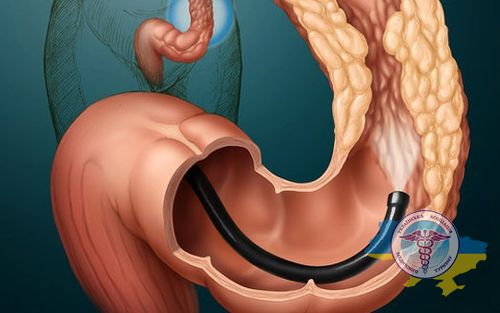Treatment of intestinal cancer in German clinics

Colon cancer is one of the most common malignant diseases. Every seventh cancer patient suffers from intestinal cancer, and more than half of the tumors are localized in the colon.
Modern methods of surgical treatment make it possible to effectively combat tumors detected at the initial stage. Treatment of bowel cancer in Germany is often carried out minimally invasively, which reduces hospitalization time and speeds up recovery. In advanced forms, radiation and drug therapy are used to prevent relapses.

Want to know how much the treatment costs?
Answer a few questions and get preliminary information about the cost of diagnosis and treatment!
Benefits of bowel treatment in Germany
German medicine is rightfully considered one of the most advanced in Europe. This was made possible thanks to the following key factors:
- High level of government funding. The country ranks 2nd in Europe in terms of budget funds invested in the medical industry. This allows us to regularly equip clinics with the most modern equipment and improve the level of service for patients.
- Quality control of medical care for foreigners. The clinic can accept patients from other countries only if it meets high requirements for staff qualifications, technical equipment and treatment effectiveness.
- Use of innovative techniques. To treat the intestines, clinics in Germany are introducing the latest developments that have undergone clinical trials in research institutes and university clinics in this country.
- Availability of specialized oncology centers. Germany has a developed network of specialized oncology centers that have highly qualified specialists, advanced diagnostic and treatment equipment and well-established interdisciplinary patient routes.
- Extensive experience in minimally invasive surgery. German surgeons annually perform thousands of high-tech, gentle operations using robotic technology. This approach allows you to achieve excellent results and significantly reduce the rehabilitation period.
- Postoperative care. Patients who have undergone complex operations are closely monitored by experienced medical staff in intensive care and intensive care units. This allows you to minimize the risk of complications and timely adjust treatment tactics.
Diagnostics of colon cancer in German clinics

Diagnosis of colon cancer in German clinics is carried out in accordance with advanced international protocols, which makes it possible to identify pathologies and precancerous changes at the earliest stages.
Histological examination
The taken tissue fragments are sent to the laboratory, where they are studied for the presence of cancer cells, their type and characteristics. In addition, genetic mutations of neoplasms are detected.
This procedure for examining patients makes it possible to make an accurate diagnosis in the early stages of the disease and begin effective therapy in a timely manner.
Computed tomography with contrast
This procedure involves obtaining multiple X-ray sections of the area of interest, which are then stitched together by a computer into a three-dimensional image. Before starting, a special substance is injected into a vein, which makes the vessels and cavities of internal organs radiopaque. Due to this, the information content of the images is significantly increased.
The study allows you to determine the exact size, location and structure of the lesion, as well as the presence or absence of signs of local spread or distant metastases.
PET-CT
This method combines functional (PET) and anatomical (CT) imaging, which significantly increases the accuracy of the examination. PET scan identifies abnormal tissues based on their increased metabolism. Before scanning, a radiopharmaceutical is injected, which is actively absorbed by cancer cells.
CT complements this distribution with precise anatomical landmarks of the organs and tissues being examined. This approach is often used to identify distant metastases, as well as to assess the effectiveness of chemotherapy.
Colonoscopy

This procedure is a visual examination of the colon using a thin, flexible tube with a camera (colonoscope). Before starting, the patient is given a mild anesthetic intravenously to relieve pain and relax muscles.
In a lateral position through the anus, the colonoscope moves smoothly along the intestinal tract and allows you to obtain accurate images of the condition of the mucous membrane along its entire length. If suspicious formations are detected, they are biopsied. The procedure takes 30-60 minutes.
Esophagogastroduodenoscopy
The procedure is a visual examination of the esophagus, stomach and the initial part of the small intestine using a flexible video endoscopic tube that is inserted through the mouth.
Preparation includes a fasting diet before the examination to obtain the clearest images of the mucous membrane. The procedure itself is absolutely painless and helps not only to visualize the condition of the tissues, but also, if necessary, to take a biopsy or perform minor surgery.
Irrigoscopy
This x-ray method involves filling the tract with a special contrast (barium) to identify defects in the relief of the mucous membrane.
Against the background of intestinal sections uniformly filled with barium, areas with reduced filling density are clearly visible, which may indicate a tumor process, inflammation or scar changes. This approach makes it possible to localize and partially characterize the identified pathology.
What intestinal cancers are treated in German clinics?
Currently, Germany is one of the most technologically equipped medical tourism destinations in Europe, including in the oncology segment. Let's look at what specific diseases are treated in German clinics.
Colon cancer
This localization of colorectal cancer is one of the most common. The tumor most often affects the sigmoid, descending and rectum. When treating colon cancer in Germany, one of the main goals is to preserve the function of the anus. If this is not possible, an artificial opening is made on the anterior abdominal wall to drain the intestinal contents.
Surgeons strive to remove the pathology along with the lymph nodes as sparingly as possible, preserving the innervation of the pelvic organs and sphincters. This way you can avoid problems with urination, potency and defecation.
Thanks to early diagnosis and modern methods of therapy, the prognosis for this disease is favorable. Even in late stages, it is possible to achieve stable remission and significantly improve the quality of life of patients.
Small intestine cancer
Malignant tumors of the small intestine are quite rare - less than 5% of all cases of gastrointestinal cancer. However, given the large extent of this section, accurate and timely diagnosis is a difficult task.
Laparoscopic and robotic methods are mainly used to remove the tumor along with the lymph nodes and nerve plexuses as carefully as possible.
For common forms, courses of radiation and drug therapy are additionally prescribed to eliminate the remaining affected cells. Thanks to the accumulated experience, in the treatment of small intestinal cancer in German clinics, more than 85% of operations are successful.
Treatment methods for colon cancer in German clinics

The choice of optimal treatment tactics is carried out by a council of doctors of different specialties. It includes oncologists, chemotherapists, radiologists, morphologists, gastroenterologists and other experts.
Only a multidisciplinary team can develop a personalized program for each patient, taking into account all the characteristics of the disease and the body.
The following methods are usually used to treat colon cancer in German clinics:
Surgery
Surgery remains one of the key stages in the treatment of colorectal cancer. In German clinics, the following types of operations can be used:
- Transanal resection. It is performed through the natural opening of the anus. It is used in the early stages when the formation is localized in the distal parts of the colon. Likewise, it allows complete preservation of the sphincter apparatus and does not require incisions in the skin.
- Laparoscopic operations. This involves removing the affected areas through several small (up to 1 cm) punctures in the abdominal wall. They are performed using video endoscopic technology and minimize intervention.
- Robotic resections. They are carried out by the Da Vinci robot using thin manipulators inserted into the abdominal cavity through punctures. The surgeon controls the operation remotely from a remote control. Provides the highest precision and allows you to preserve healthy body tissue.
- Open operations. They are performed in a standard way through a large incision in the anterior abdominal wall. They are used for multiple or hard-to-reach lesions of the colon. The most traumatic, but in some cases irreplaceable method.
Conservative therapy
Along with the surgical method, the most important components of the complex treatment of oncological diseases of the intestinal tract is conservative therapy. Its task is to eliminate as much as possible the remaining cancer cells after surgery to prevent relapse and metastasis.
At different stages, doctors can use:
Radiation therapy

Irradiation with ionizing radiation is used in the complex treatment of colorectal cancer at the initial stage to reduce the size of the tumor before surgery, after resection of the primary lesion, as well as in extensive unresectable forms as an independent or combined method.
Medical specialists in Germany use modern high-precision techniques - stereotactic and interstitial radiation therapy, in order to act as carefully as possible on the lesion and preserve surrounding tissue.
Chemotherapy
Used for systemic action on possible remaining cancer cells, including micrometastases. Treatment regimens are selected individually, taking into account histology, molecular genetic characteristics of the tumor and the patient’s concomitant pathology.
The procedure is performed intravenously through an installed port and is prescribed in courses of 2-3 weeks with breaks for recovery and prevention of complications. Chemotherapy is also often prescribed in terminal stages of cancer to relieve symptoms.
Immunotherapy
This method is based on the use of drugs that activate the body's own defenses to fight the disease. These are mainly monoclonal antibodies, vaccines and specific antigens.
The drugs affect the immune system and train it to recognize and eliminate cancer cells. The course is selected individually, taking into account the molecular characteristics of the tumor.
Targeted therapy
Involves a targeted effect on proteins that are responsible for the growth and division of cancer cells. This allows for maximum selective influence on the pathological focus, thereby preserving healthy tissue.
Prescribed in the form of tablets, both as part of complex therapy and as an independent method. The duration of the course is determined individually.
Innovative techniques
- HIPEC therapy. This method is used for multiple colon metastases. During the procedure, surgeons remove the tumor and then inject a chemotherapy solution heated to 41-42°C directly into the abdominal cavity. High temperature promotes deep penetration of the drug into tissues and destroys more cancer cells compared to traditional chemotherapy.
- Stereotactic radiosurgery. High-precision robotic method of local irradiation with high doses of ionizing radiation. In German clinics, modern radiosurgical units (Gamma Knife or Cyber Knife) are used for this, which are still practically unavailable to patients from Ukraine. This approach effectively destroys cancer cells while preserving healthy tissue.
- Focused ultrasound. This technology uses high-intensity ultrasonic waves that are concentrated directly in the affected area. Local tissue heating occurs to 45-60°C, which leads to the destruction of the pathology. It is used both to reduce tumor size before surgery and as an independent procedure.
- Cryodestruction. It is based on the influence of ultra-low temperatures (-180-1960C) using special cryoapplicators. Leads to the formation of ice inside the cells and their rupture. It is used more often for lesions that are superficial or accessible to a cryoprobe.
- Photodynamic therapy. Derivatives of chlorophyll and porphyrin are usually used as photosensitizers. Under the influence of light quanta of a certain wavelength, cytotoxic reactions are triggered in the production of reactive oxygen species, leading to the death of cancer cells.
- T-helper technology. When choosing this technique, T-lymphocytes are isolated from the patient's lymphocytes, which are subsequently injected into the patient to stimulate an immune response against the disease. The highest effectiveness is achieved when T-helper cells are combined with immune checkpoint inhibitors.
Cost of bowel cancer treatment in Germany
When calculating the price of bowel cancer treatment in Germany, the following factors are taken into account:
- Stage of the disease. In later stages, a more expensive comprehensive examination is required to identify possible metastases. In addition, in addition to surgery, additional therapy with targeted and immune drugs is prescribed.
- Scope of diagnostics. If part of the examination has already been carried out in your home country, this can significantly reduce the cost of diagnosis in Germany. It is enough to provide the medical center with ready-made research results and histological biopsy blocks.
- Types of prescribed medications. All drugs prescribed for targeted, immune or chemotherapy are quite expensive, and some of them must be taken in regular courses of many months or years.
- Type of clinic. The cost of intestinal treatment in German private clinics, equipped with the most modern equipment, is usually more expensive than in public medical centers.
- Hospitalization. When treating in a hospital, it is necessary to take into account the cost of living in the ward during the preoperative examination, surgery and postoperative recovery.
- Rehabilitation. After discharge from the hospital, it is recommended to take a course in a specialized clinic to restore the functioning of the gastrointestinal tract and the body as a whole. This may take from 2 weeks to 2 months. The cost depends on the duration of the rehabilitation program, the type of procedures and the level of the medical institution.
Average prices for the most popular services are shown in the table:
| Procedure | Cost, € |
|---|---|
| Consultation with a gastroenterologist | from 300 |
| Colonoscopy | from 1500 |
| Chemotherapy | from 2500 |
| Immunotherapy | 7200 |
| Cyber knife | 8700 |
| Intraperitoneal chemotherapy HIPEC | from 21000 |
| Colectomy (resection of the colon) | from 30000 |
| Radiation therapy | from 10000 |
| Da Vinci Robotic System | 19600 |



